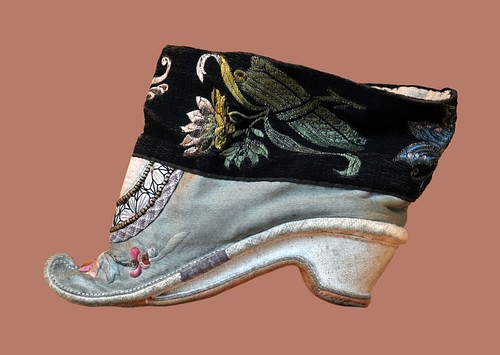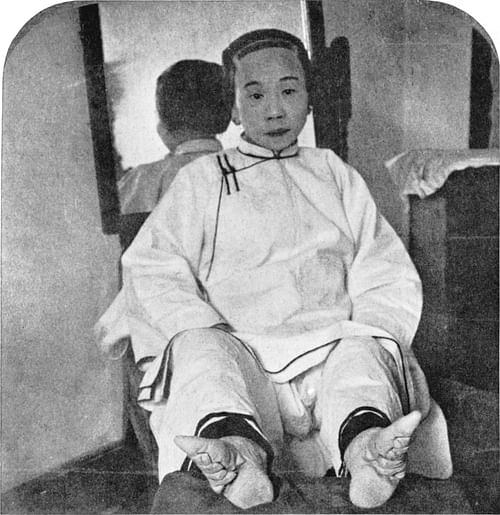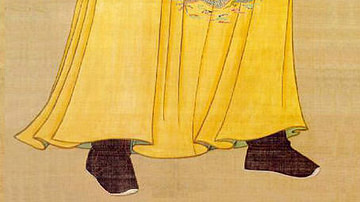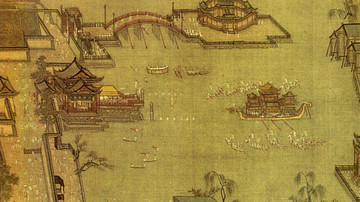
Foot-Binding was a practice first carried out on young girls in Tang Dynasty China to restrict their normal growth and make their feet as small as possible. Considered an attractive quality, the effects of foot-binding were painful and permanent. It was widely used as a method to distinguish girls of the upper class from everyone else, and later as a way for the lower classes to improve their social prospects. The practice of foot-binding continued right up to the early 20th century CE.
The Foot-Binding Process
Chinese girls had their feet bound typically from the age of five to eight. The process began by choosing an auspicious day in the calendar. Next prayers and offerings were offered to the Tiny-Footed Maiden Goddess; another recipient was the Buddhist figure of Guanyin, a bodhisattva or enlightened one who was thought to protect women in general. When all was ready, the task was done by the older women of the family or by a professional foot-binder. The big toe was left facing forwards while the four smaller toes were bent under the foot. In this position, the feet were tightly bound using long strips of cloth, which then restricted any future growth and gave the foot a pronounced arch. The feet were unbound after one month, any ulcerations of the skin treated, and the foot rebound again. The bindings were loosened and retightened thereafter once each month until the girl reached her early teens (or even longer depending on the desired effect). It was not uncommon for one or more toes to be lost or to have infections in the foot or gangrene. Even as an adult a woman continued to wrap her deformed feet in bindings, wearing them at all times in public and when bathing.
The aimed result of the long and excruciating process was to have feet no longer than 7.5-10 cm (3-4 inches), when they were known as jinlian - “Golden Lotus” or “Lotus” feet after the central life symbol of Buddhism. The smaller the feet the more attractive they were, even erotic for some, and it became a distinct mark of elegance. The same was true of the style of walking a woman with bound feet was now forced to adopt - small, light steps. With servants to perform menial tasks, a lady's mobility was limited even in normal circumstances, but with bound feet, walking must have only been achieved with great difficulty. Smaller feet required especially dainty shoes, and these, made of silk or cotton and often beautifully embroidered, have been found in abundance in tombs of Chinese upper-class women.
Historical Origins & Spread
The practice of binding feet may have started with the dancer Yaoniang, who performed in the Tang dynasty court, or more generally the Turkic dancers who performed there during the 10th century CE. These dancers were known for their small feet and “bow-shoes” which had upturned toes. The first mention in historical records dates to when the Tang court was at Nanking between 937 and 975 CE.

Certainly, the binding of feet to reduce their size was long-associated with women who earned their money entertaining men in one way or another. Another reason for its popularity may have been a desire to clearly differentiate upper-class Chinese women, the Han in particular, from the lower classes, those women from the provinces, and those belonging to cultures from newly acquired territories. Conversely, people in the provinces and peripheral regions of China wanted to copy the 'civilising' practices of imperial China. Finally, aristocratic young men of the Tang period were becoming more refined in dress and appearance so that foot-binding may have been an attempt to further distinguish the sexes.
The practice became widespread among the upper classes during the Song dynasty (960-1279 CE), especially in central and northern China. Subsequently, foot-binding was performed on girls of all classes. The widespread nature of the practice by aristocrats meant that lower class parents saw foot-binding as an opportunity to raise the prospects of their own children. Eventually, the trait became something to take careful note of by parents arranging the marriage of their son. Tiny feet, despite the origins amongst dancers and courtesans, came to symbolise not only elegance but also moral virtue and modesty. There thus developed a certain peer pressure amongst families to perform the process on their daughters or risk not finding them eligible husbands. An additional test of a girl's suitability was her being set the task of making small shoes for the bound feet of her future in-laws.
That foot-binding became very common is evidenced by the fact that Chinese writers from the 12th to 14th century CE anticipate their readers are familiar with it. There developed certain proverbs, too, like Teng er bu teng xue, teng nu bu, teng jiao, meaning something like “if you care for your children, do not worry if your son suffers for his studies or your daughter for her feet” (Blake, 681). The lack of mobility would not have greatly affected working women in their traditional household employment of spinning, weaving, sewing, and embroidery. In those regions of China where women were more involved in agricultural work such as the cultivation of wet rice, foot-binding was less common.
The process even came to the attention of some foreign visitors, and one such source is Friar Odoric of Pordenone who visited northern China between 1322 and 1328 CE. The friar made the following note on the practice:
And with the women the great beauty is to have little feet; and for this reason mothers are accustomed, as soon as girls are born to them, to swathe their feet tightly so that they can never grow in the least. (Gamble, 181).
Studies of a sample village of over 500 families in 1929 CE (Tinghsien) showed that it was almost a universal practice amongst women over 40 years of age but reduced to around half when considering the female population as a whole.
Was There a Reaction to Foot-Binding?
Obviously being a painful process and leaving women so treated with permanent problems of mobility, which also seriously limited any role they could take on in wider society, the practice was not without its critics. The Qing poet Yuan Mei (1716-1797 CE) was one notable figure who was publicly against foot-binding, and Confucian scholars remained unimpressed, associated as it was with women of the 'entertainment' industry and having the sole purpose of making the woman more attractive. The emperor Chun Chi, of the Manchu dynasty which never practised foot-binding at court, tried to impose a ban in 1645 CE but the measure was not successful. Emperor K'ang Hsi made another attempt in 1662 CE but, realising he was fighting a losing battle against parents, he withdrew the ban in 1668 CE. By the 18th century CE there were occasional popular movements to stop the practice but still, despite the pains and consequences, foot-binding remained a common practice in China into the early 20th century CE.










